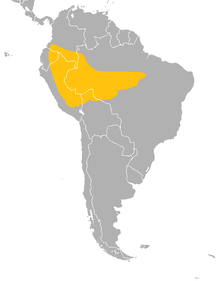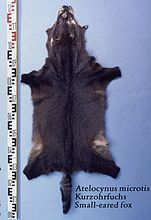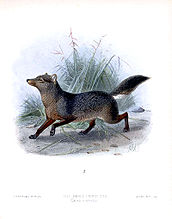Short-eared fox
| Short-eared fox | ||||||||||||
|---|---|---|---|---|---|---|---|---|---|---|---|---|

Short-eared fox ( Atelocynus microtis ) |
||||||||||||
| Systematics | ||||||||||||
|
||||||||||||
| Scientific name of the genus | ||||||||||||
| Atelocynus | ||||||||||||
| Cabrera , 1940 | ||||||||||||
| Scientific name of the species | ||||||||||||
| Atelocynus microtis | ||||||||||||
| ( Sclater , 1883) |
The short-eared fox ( Atelocynus microtis ) is a South American species of real dogs and the only representative of the genus Atelocynus .
features
The short-eared fox is characterized by its slim, supple physique, which is more reminiscent of a genet or civet than a dog. He also moves with a feline elegance and ease. The length from the tip of the snout to the base of the tail is 72-100 cm, the tail is another 25-35 cm long. The shoulder height is around 35 cm and the weight is around 9 or 10 kg. The round ears are only 3.5 to 5 cm long, and in relation to body size shorter than any other living dog species. The coat color is dark gray to black on top, reddish on the underside with gray and black tones, while the thickly hairy tail is black with the exception of a light area on the underside. The molars are well developed. The males in particular have strong smelling anal glands.
Distribution and existence
The distribution area of the short-eared fox are the Amazon basin , the upper Orinoco basin and the upper Paraná basin in South America. It occurs in the states of Brazil , Peru , Ecuador , Colombia and possibly in Venezuela .
It appears to be rare in some states, but reliable population estimates are difficult to make due to their nocturnal and solitary lifestyle.
Way of life
Its habitat are tropical forests below 1000 m altitude. In contrast to the forest dog, with which it shares its habitat, the short-eared fox hunts as a loner. It mainly catches small or medium-sized rodents. In captivity, it eats meat, fruit and even garbage. The behavior of this species has hardly been researched so far. A male from the Brookfield Zoo was docile and docile, while his female would growl in the presence of people.
photos
literature
- Ronald M. Nowak: Walker's Mammals of the World . Johns Hopkins University Press, 1999 ISBN 0-8018-5789-9 .
- David Macdonald: The Great Encyclopedia of Mammals . German edition: Könemann in der Tandem Verlag GmbH, 2004 ISBN 3-8331-1006-6 .
- Claus Hilschmann: Fauna Volume 8 The Neotropical Region , Novaria-Verlag, 1971. ISBN 3-87991-048-0 .
Web links
- Leite-Pitman, MRP & Williams, RSR 2011. Atelocynus microtis . In: IUCN 2012. IUCN Red List of Threatened Species. Version 2012.2. (species is listed as "near threatened")
- Distribution map IUCN



